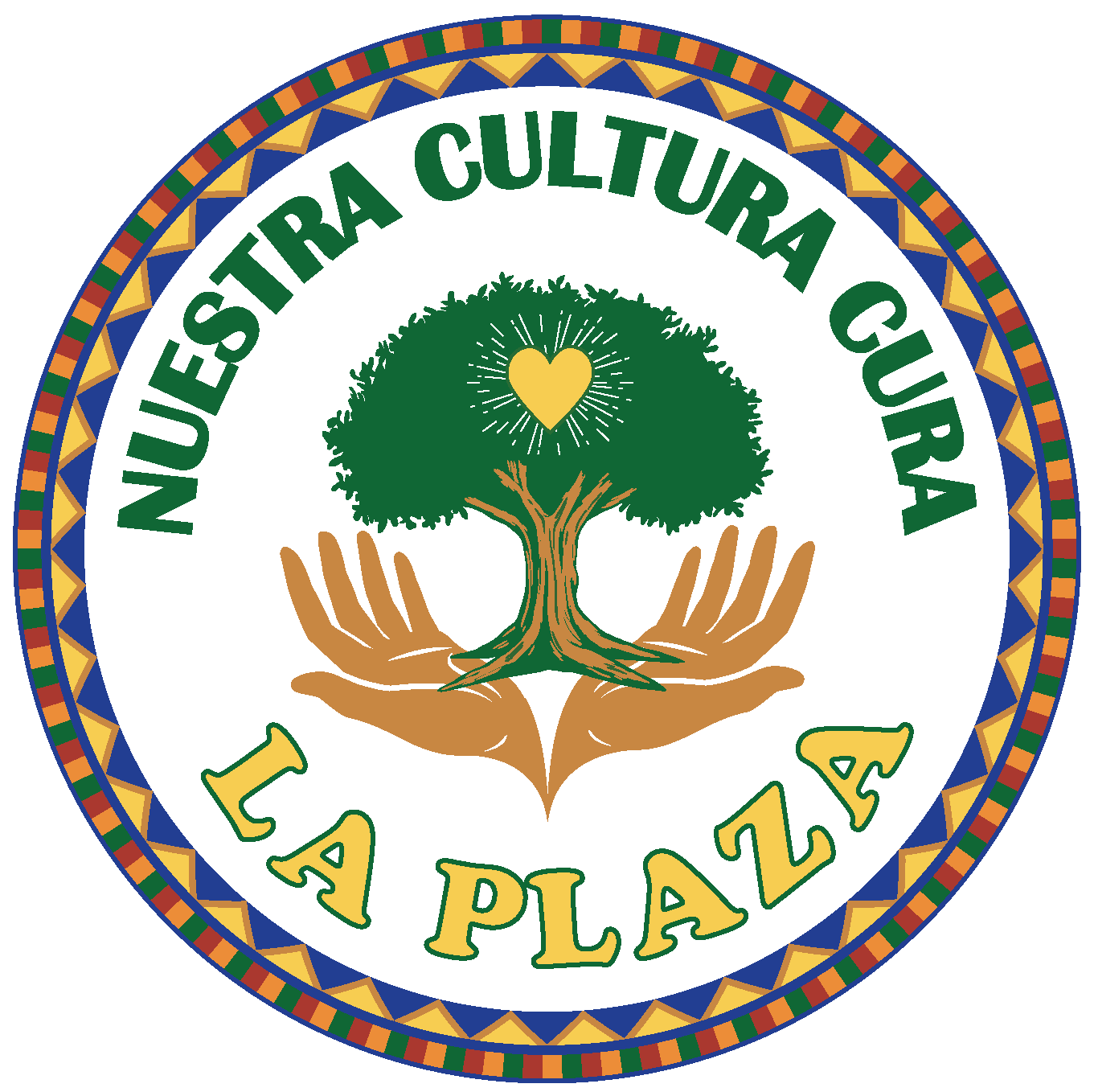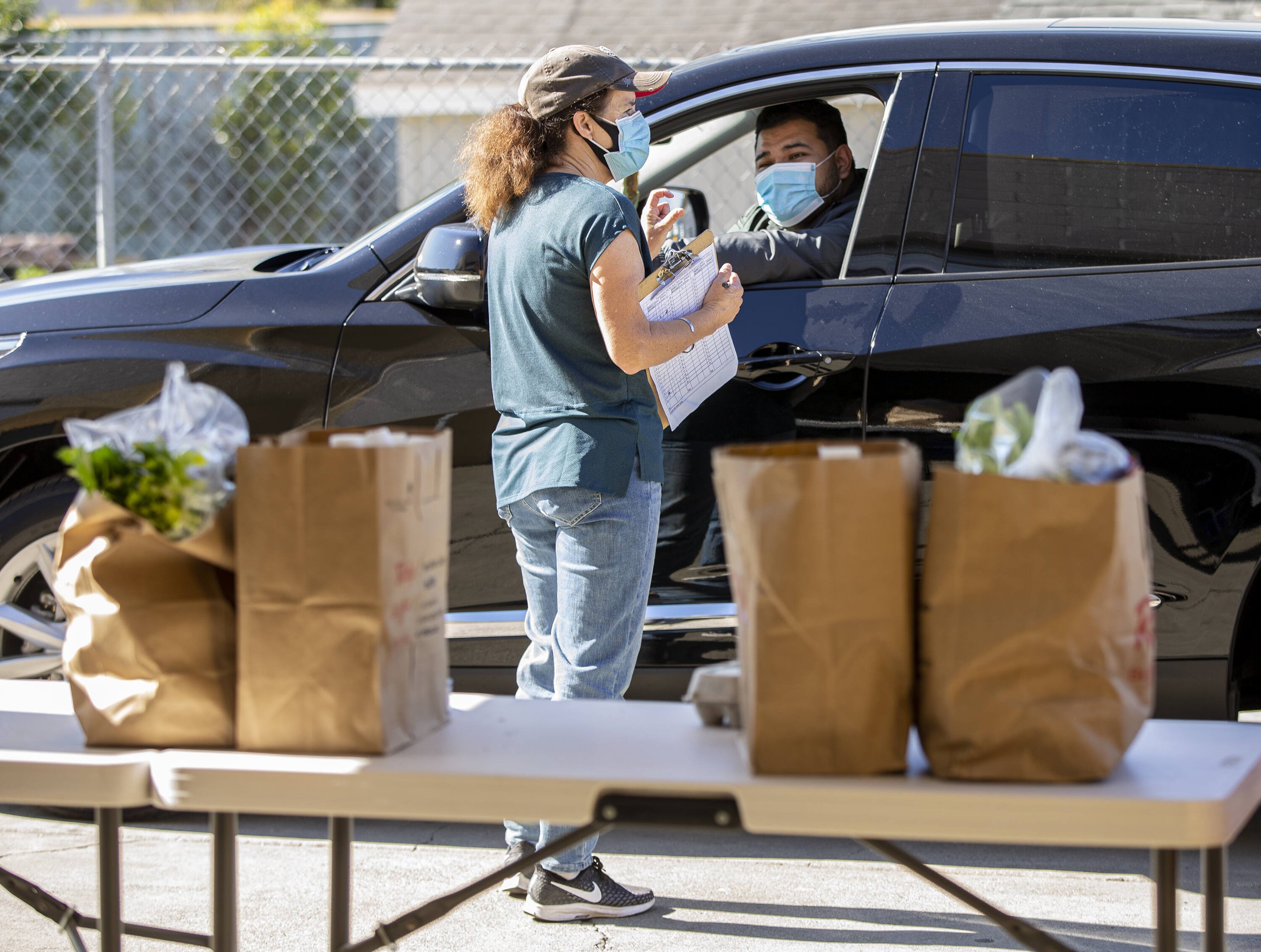For thousands of low-income residents in Sonoma County, pre-pandemic normal simply meant less misery
By MARTIN ESPINOZA AND EMMA MURPHY
New COVID-19 infections and hospitalizations are in decline, and pandemic restrictions are slowly being lifted.
People are once again hoping for a return to “normal” life, where they can gather freely, work in offices, enter restaurants without masks, and shake hands rather than bump elbows.
But for thousands of low-income residents in Sonoma County — many of them Latino and many of them undocumented immigrants — a return to normal will mean something different.
There won’t necessarily be more joy, just less misery.
Kerin McTaggert of FISH food pantry, greets Ramses Zarate picking up groceries during the drive-thru event on Tuesday Feb. 8, 2022. (Chad Surmick / The Press Democrat)
Volumes of public health statistics continue to show that COVID-19 infections hit hardest in places that reflect the county’s long history of economic, ethnic and racial disparities.
Health advocates and county health officials say these “preexisting” inequalities are not going to disappear once public health restrictions are lifted.
“Normal was never good for our undocumented residents, our low-wage workers, and so we don’t want to go back to normal,” said Oscar Chavez, assistant director of Sonoma County Human Services Department.
Chavez said the post-pandemic challenge will be to “change the way normal looks” and make recovery more equitable.
“What we know from this pandemic, and any disaster, is that it is always our most vulnerable that are the hardest hit — our disabled, our elderly, our undocumented, our communities of color,” he said. “And they’re also the last to recover.”
That’s the case for people like Lizet Castañeda, a Cloverdale wine industry worker who will be clawing back to the margins of our local economy long after the pandemic is over as she struggles to find enough work to pay for rent and buy groceries.
For her and many other low-wage workers, the frustration of wearing a face mask and being unable to gather with friends is the least of her concerns.
Though most Sonoma County residents have felt some form of psychological and emotional strain in the past two years, those who lost a loved one to COVID-19, experienced severe illness, were hospitalized or suffered extreme financial hardship experienced a distinctly different pandemic reality.
Citing observations made by University of Southern California ethnic studies professor Manuel Pastor during a visit to Sonoma County in November, Chavez said COVID-19 was the disease that revealed the illness in our society.
“We were just not prepared,” Chavez said. “Whatever idea of a safety net we thought we had, COVID proved us wrong. And so, we’ve got to re-imagine what a safety net, a responsive safety net, looks like for our vulnerable populations.”
Layers of misery
During the omicron-fueled winter surge, the virus swept through Lizet Castañeda’s small two-bedroom apartment in Cloverdale, infecting her, her husband and her adult son. The 52-year-old works at a local winery, washing tasting room glasses.
Castañeda, who was fully vaccinated but not boosted, said she’s not sure where she contracted the virus, but one day in mid-January, she started feeling body aches. Her husband came down with a fever, she said. All tested positive.
Castañeda said like many other immigrants, she does not have paid sick leave and cannot afford to take time off.
Her biggest worry, she said, is her ability to pay her rent in her motel-like apartment, which is due to increase from $1,348 to $1,420 a month in March. She said that if the rent is not paid after five days past the due date, she’s charged $50 a day.
“There are people who are working who are infected but still working because they have to keep working,” she said, speaking in Spanish. “I’m afraid that I’ll get sick again.”
Like many other low-income immigrants in Cloverdale, Castañeda has received help navigating through the pandemic from La Familia Sana, a grassroots nonprofit that promotes health and wellness among disadvantaged Latino and Indigenous-language communities.
Mayra Arreguin, an organizer with La Familia Sana, spends much of her days canvassing modest apartment complexes in Cloverdale, in search of families that have run out of food or are struggling with rent payments and utility bills. She connects them with pandemic-related financial assistance and food bank donations.
She said the funds available are simply inadequate to meet the widespread need, particularly among seasonal farmworkers.
“There are workers who can only get a few hours here and there,” she said, speaking in Spanish. “In past years, workers would be given steady work pruning, eight hours a day. Now there’s no work. Farmworkers are suffering a great deal right now.”
Javi Cabrera-Rosales, project director of the CURA Project, which provides pandemic assistance to Latino, Indigenous and low-income communities, said Sonoma County residents who “live on the margins” do not have the same access to resources that most other people have.
He said everyone has a right to reclaim some semblance of normalcy, but those who are less privileged should not be forgotten. And their needs in a post-pandemic scenario should be no less important that the parent who “wants to watch their kid play basketball.”
“A large portion of our society that bears the brunt and is the backbone of many of the essential jobs that keep a lot of our society going and flowing are being seen as invisible,” he said. “If we really want to get to a place of understanding and unity, we need to recognize the impact on all of the people of Sonoma County.”
Omicron crosshairs
During the omicron surge, COVID-19 transmission rates for Latino residents skyrocketed, peaking at 323 new daily infections per 100,000 residents before coming down to levels comparable with other ethnic and racial groups. Native Americans, though a much smaller population in Sonoma County, also saw their case rates spike dramatically this winter, reaching 303 new infections per 100,000.
The case rate for white residents, though also high during the winter surge, was 134 new cases a day per 100,000 people, less than half the rate of virus spread for Latinos.
To better understand the impact of poverty on virus transmission, Robin Hauscher, a biostatistician with the county public health division, examined the cases broken down by race and ethnicity. The results were analyzed against state averages of the Healthy Places Index (HPI), a composite measure of socioeconomic opportunity applied to census tracts that includes more than two dozen individual indicators across economic, social, education, transportation, housing, environmental and neighborhood sectors.
Hauscher found that within the Latino population, more COVID-19 cases were generated within county census tracts that fell below the state’s average HPI economic score. Early in the pandemic, county health officials learned that the pandemic was impacting Latinos and other minority groups disproportionately — and that trend has been one of the only constants during the two-year crisis.
Latinos, for example, are only 27% of the population but comprise 50% of all COVID-19 cases since the pandemic began.
Some 30,338 Latinos have been infected since spring of 2020 — that’s roughly 19% of that population. In contrast, 24,926, or 9%, of the county’s roughly 285,792 white residents have been infected.
On Wednesday, county public health officials acknowledged that even as the winter surge subsides and public health rules are loosened, essential workers and communities of color will continue to be impacted by COVID-19 and will need additional support to limit health disparities.
Last week, officials announced that indoor masking rules would be loosened after Feb. 15, allowing vaccinated residents to shed their masks in public spaces. And on Friday, the county lifted its ban on large public gatherings. But county officials noted the road to real recovery will require more than loosening restrictions.
“People assume that we’re over the worst of the pandemic, and the impact — especially on wages, food insecurity, housing insecurity— is still with us,” said Supervisor Susan Gorin.
To meet that need, the county has relied heavily on local health clinics, and on organizations like La Familia Sana in Cloverdale and the COVID-19 Urgent Response & Aid Project. Between Jan. 1 and Jan. 27, the CURA Project received an average of 1,100 calls every three days from community members in need of emergency financial assistance.
During a Board of Supervisors meeting last week, officials discussed the coming economic crisis facing low-income residents. Dr. Urmila Shende, the county’s vaccine chief, and Tina Rivera, director of county health services, said housing insecurity due to expired tenant protections and food insecurity were common issues that callers needed help with.
Health officials said CURA, the county’s primary safety net for communities of color and low-income residents, is about to run out of money. Rivera said the county is looking to grants as a possible solution to help resolve CURA’s depleting funds.
Gorin and Supervisor Chris Coursey pointed out those who have suffered the most through the pandemic are often not as vocal or well-connected as the county’s more privileged residents.
“It’s important to recognize that those people are still struggling. They’re not attending Board of Supervisors meetings and complaining about things, but they are out there,” Coursey said.
According to an update to the county’s Portrait of Sonoma report, the share of county residents who live in poverty decreased from about 12% in 2014 to 6% in 2019. More recent U.S. Census Bureau data also show a significant decline.
But for those who are feeding the county’s hungry every day, those statistics simply don’t make any sense.
Jennifer Emery, executive director of FISH of Santa Rosa, a food pantry in southwest Santa Rosa, said that between 2020 and 2021, food donations have increased 56%, even as hours at the pantry’s drive-thru on Sebastopol Road have been cut down to two hours.
FISH, which stands for Friends in Service Here, is the only all-volunteer food pantry in Sonoma County and serves a wide cross section of residents, including single moms with kids, seniors, and people who are homeless. The majority, she said, are Latino.


